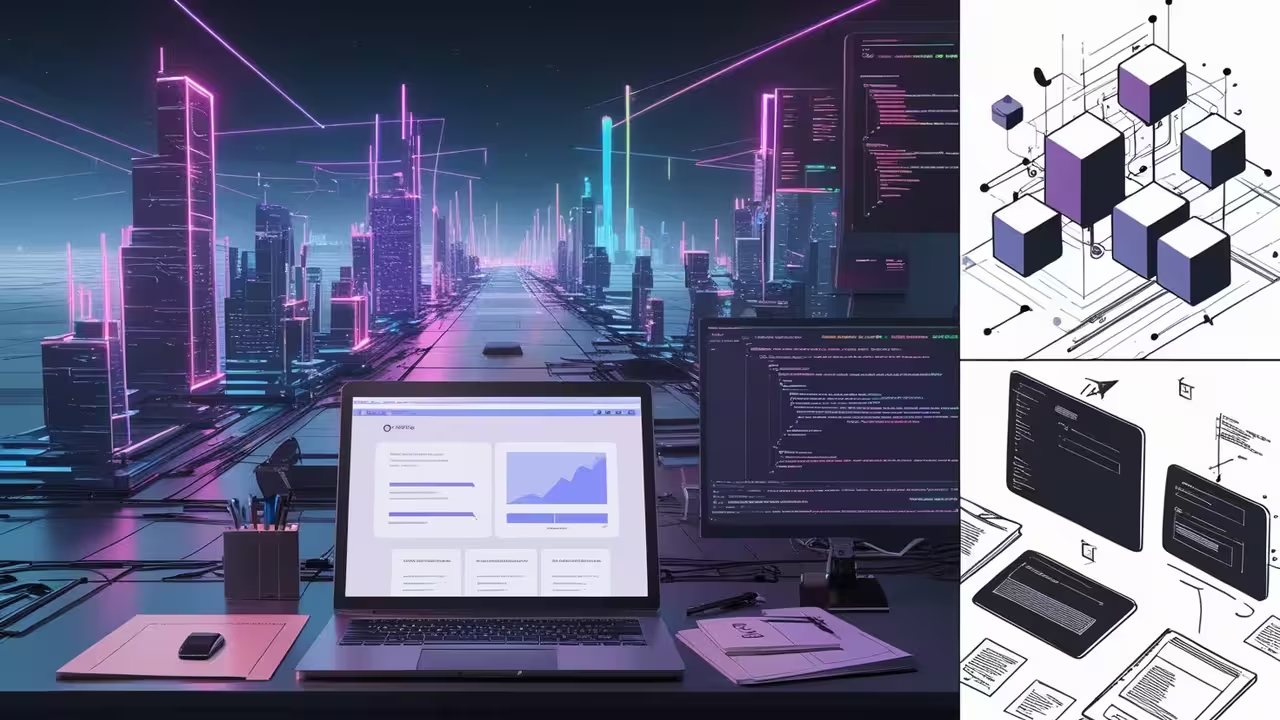
Introduction:
Web development service is one of the most exciting and in-demand skills in today’s digital world. Whether you’re looking to build websites, create web applications, or even become a web developer, this guide will walk you through everything you need to know. From understanding the basics to exploring advanced concepts, we’ll cover it all in a simple, friendly, and engaging way.
So, what exactly is web development? In simple terms, it’s the process of creating and maintaining websites or web applications. It involves coding, designing, and ensuring that everything works smoothly for users. Whether you’re a beginner or someone looking to brush up on your skills, this guide is for you. Let’s dive in!
What Is Web Development?
Web development is the art and science of building websites and web applications. It’s what makes the internet functional and visually appealing. Think of it as constructing a house. You need a strong foundation (HTML), a beautiful design (CSS), and interactive features (JavaScript) to make it livable.
There are three main types of web development:
- Front-end development: This focuses on what users see and interact with, like buttons, menus, and layouts.
- Back-end development: This deals with the server-side, where data is stored and processed.
- Full-stack development: This combines both front-end and back-end skills, making you a versatile developer.
Why Learn Web Development?

Web development is a skill that opens doors to countless opportunities. Here’s why you should consider learning it:
- High demand: Companies everywhere need web developers to build and maintain their online presence.
- Creative freedom: You can bring your ideas to life by creating websites or apps.
- Flexibility: Many web developers work remotely or freelance, giving them control over their schedules.
- Good pay: Web developers are well-compensated for their skills.
Plus, with the rise of technologies like JavaScript, Python, and frameworks like Django and Node.js, web development is more exciting than ever.
The Basics of Web Development
Before diving into complex topics, let’s start with the basics. Every website is built using three core technologies:
1. HTML (HyperText Markup Language)
HTML is the backbone of any website. It structures the content, like headings, paragraphs, and images. Without HTML, a website would just be a blank page.
2. CSS (Cascading Style Sheets)
CSS is what makes a website look good. It controls the colors, fonts, and layout. With CSS, you can turn a plain HTML page into a visually stunning site.
3. JavaScript
JavaScript adds interactivity to websites. It’s what makes buttons clickable, forms submit data, and animations run. Without JavaScript, websites would feel static and boring.
Front-End vs. Back-End Development
Understanding the difference between front-end and back-end development is crucial.
Front-End Development
Front-end developers focus on the user interface (UI) and user experience (UX). They use HTML, CSS, and JavaScript to create responsive and visually appealing web pages. Tools like Bootstrap and frameworks like Angular are often used to streamline the process.
Back-End Development
Back-end developers work behind the scenes. They handle databases, server logic, and ensure everything runs smoothly. Popular back-end programming languages include Python, PHP, and Ruby. Frameworks like Django and Node.js are also widely used.
Becoming a Web Developer
If you’re wondering how to become a web developer, here’s a step-by-step guide:
- Learn the basics: Start with HTML, CSS, and JavaScript. These are the building blocks of web development.
- Choose a specialization: Decide whether you want to focus on front-end, back-end, or full-stack development.
- Practice coding: Build small projects like a personal portfolio or a to-do list app.
- Learn frameworks: Explore popular frameworks like React, Angular, or Django to speed up your development process.
- Build a portfolio: Showcase your projects to potential employers or clients.
- Stay updated: Web development is always evolving, so keep learning new tools and technologies.
Essential Tools for Web Development
To excel in web development, you’ll need the right tools. Here are some must-haves:
- Text editors: Tools like Visual Studio Code or Sublime Text help you write and organize your code.
- Version control: Git and GitHub allow you to track changes and collaborate with others.
- Frameworks: Frameworks like Bootstrap (for CSS) and Django (for Python) make development faster and easier.
- Browser developer tools: These help you test and debug your code directly in the browser.
The Future of Web Development

The world of web development is constantly evolving. By 2025, we can expect even more advanced technologies and trends. Here are a few predictions:
- AI integration: Artificial intelligence will play a bigger role in creating personalized user experiences.
- Progressive web apps (PWAs): These will combine the best features of websites and mobile apps.
- Voice search optimization: As voice assistants become more popular, websites will need to adapt.
- Enhanced security: With cyber threats on the rise, developers will focus more on securing web applications.
Common Challenges in Web Development
Web development isn’t always easy. Here are some challenges you might face:
- Browser compatibility: Ensuring your website works well on all browsers can be tricky.
- Responsive design: Making your site look good on both desktop and mobile devices requires careful planning.
- Keeping up with trends: The tech world moves fast, so staying updated is essential.
- Debugging: Finding and fixing errors in your code can be time-consuming.
Tips for Success in Web Development
Here are some tips to help you succeed as a web developer:
- Start small: Don’t try to learn everything at once. Focus on mastering the basics first.
- Join a community: Connect with other developers online or in person to share knowledge and get support.
- Be patient: Learning web development takes time, so don’t get discouraged.
- Practice regularly: The more you code, the better you’ll get.
How to Build Your First Website
Building your first website is an exciting step in your web development journey. Here’s how to get started:
- Plan your website: Decide what your website will be about and what pages it will have.
- Create a layout: Use HTML to structure your content and CSS to style it.
- Add interactivity: Use JavaScript to make your website more engaging.
- Test your site: Check how your website looks on different devices and browsers.
- Publish your site: Use a hosting service to make your website live on the internet.
The Role of Frameworks in Web Development
Frameworks are like toolkits that make web development easier. They provide pre-written code and templates, so you don’t have to start from scratch.
For example:
- Bootstrap: A CSS framework that helps you create responsive designs quickly.
- Django: A Python framework that simplifies back-end development.
- React: A JavaScript framework for building interactive user interfaces.
Using frameworks can save you time and help you build better websites.
Why Responsive Design Matters

Responsive design means making sure your website looks good on all devices, from desktops to smartphones.
Here’s why it’s important:
- Better user experience: People are more likely to stay on your site if it’s easy to use.
- Higher search rankings: Search engines like Google prefer websites that are mobile-friendly.
- More visitors: A responsive design ensures everyone can access your site, no matter what device they use.
How to Debug Your Code
Debugging is the process of finding and fixing errors in your code. Here are some tips to make it easier:
- Use browser tools: Most browsers have built-in tools to help you find errors.
- Check your code line by line: Sometimes, a small mistake can cause big problems.
- Ask for help: If you’re stuck, don’t be afraid to ask other developers for advice.
The Importance of Version Control
Version control is like a save button for your code. It lets you track changes and go back to previous versions if something goes wrong.
The most popular version control system is Git, and GitHub is a platform where you can store and share your code.
Using version control is essential for working on big projects or collaborating with others.
FAQs About Web Development
1. What is the difference between web development and web design?
Web development focuses on coding and building the functionality of a website, while web design deals with the visual aspects, like layout and colors.
2. Do I need a degree to become a web developer?
No, many web developers are self-taught or learn through online courses and bootcamps.
3. How long does it take to learn web development?
It depends on your dedication, but most people can learn the basics in 3–6 months.
4. What programming languages should I learn for web development?
Start with HTML, CSS, and JavaScript. Then, explore languages like Python, PHP, or Ruby for back-end development.
5. What is a full-stack developer?
A full-stack developer is someone who can work on both the front-end and back-end of a website.
6. Is web development a good career choice?
Yes, web development offers great job opportunities, competitive salaries, and the chance to work on exciting projects.
Conclusion
Web development is a rewarding and dynamic field that offers endless possibilities. Whether you’re building websites, creating web applications, or exploring new technologies, there’s always something new to learn. By mastering the basics, staying updated with trends, and practicing regularly, you can become a skilled web developer.
Stay ahead in the world of web development! Follow us for expert tips, latest trends, and valuable insights. World Rankes Agency




